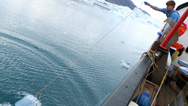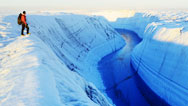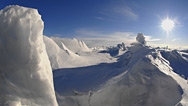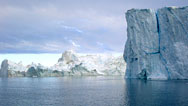See a Glacier Like Never Before
- By Ari Daniel
- Posted 09.24.15
- NOVA
Helheim Glacier is a landscape unto itself. It fills an entire fjord in southeast Greenland with its rugged ice pinnacles and crevasses. Melt water and dirt mingle on the surface, while icebergs the size of stadiums calve off and head towards the North Atlantic. And this glacier is just one of thousands that drain the Greenland ice sheet.
Transcript
Ari: Think you know what a glacier is? Well, think again. I’d like you to meet Helheim, a glacier in southeast Greenland.
Gordon: First of all—it’s not completely white, and it’s not completely flat. The surface is usually a mixture of whites and grays, iridescent blues, and also some darker colors that are the accumulation of dust on the surface.
Ari: Helheim is like a giant river of ice, originating—like a lot of glaciers up here—as snow that falls upon the Greenland ice sheet over tens of thousands of years.
Gordon: It starts to flow downhill, and as it approaches the coast, it starts to get funneled into these steep-walled valleys. And there the flow starts to accelerate.
Ari: Turns out that sometimes a “glacial pace” is really fast. Helheim’s moving three feet per hour.
Gordon: Because the glacier’s moving so fast, it cracks apart, and so you have pinnacles of ice and these great, yawning crevasses. You could drive easily several school buses into them, and there would still be plenty of space to leave an open void.
Ari: In the summertime, melt water cascades along Helheim’s edges. And if you kneel down, you find these turquoise pools filled with cryoconite—a fancy name for dirt.
Helheim is a landscape unto itself.
Now, if you move in the direction that Helheim is flowing, you eventually get to the terminus, where the glacier meets the ocean.
Gordon: You can think of it as a vertical face of ice. We can only see the part that’s above the waterline.
Ari: For Helheim, that part’s almost 25 stories tall. It plunges another half mile into the ocean below.
Gordon: And icebergs are constantly calving off that terminus into the ocean. But there’s such a volume of ice coming off Helheim glacier that those icebergs can’t escape the fjord fast enough. So they all kind of jumble together, and it becomes this semi-rigid matrix of icy blocks that we call the mélange.
Ari: Ten to 15 miles farther down the fjord, we leave the mélange behind and the icebergs drift more freely. Ths fjord connects Helheim and the North Atlantic. Along the way, the icebergs melt. And all the while, water, in the form of snow, has been falling upon the Greenland ice sheet, replenishing Helheim and other glaciers like it.
Gordon: And it’s just an amazing, immense amount of mass that’s being moved by these systems.
Ari: Helheim is just one of hundreds of glaciers in Greenland. And they’re all different—just like giant snowflakes.
Credits
PRODUCTION CREDITS
- Videography, Production, and Narration
- Ari Daniel
- Financial support for reporting provided by:
- the Pulitzer Center on Crisis Reporting
- Original Footage
- © WGBH Educational Foundation 2015
MEDIA CREDITS
- Drone Videography
- Greg Hanlon & Adam LeWinter
- Laser Animation
- US Army Corps Cold Regions Research and Engineering Laboratory
University of Maine
University of Kansas - Additional Imagery
- Adam LeWinter
Kate Raisz
Creative Film
Google Maps - Music
- APM
IMAGE
- (Main image: Aerial glacier shot)
- Greg Hanlon & Adam LeWinter
Related Links
-

Waging Science on the High Seas
Doing science in the Arctic is tough. Here's why that's a good thing.
-

Extreme Ice
An acclaimed photographer teams up with scientists to document the runaway melting of arctic glaciers.
-

Secrets Beneath the Ice
Is Antarctica headed for a catastrophic meltdown? New evidence of ancient climate change may hold clues.
-

Fastest Glacier
A glacier moving way too fast reveals how unpredictable the effects of global warming can be.

